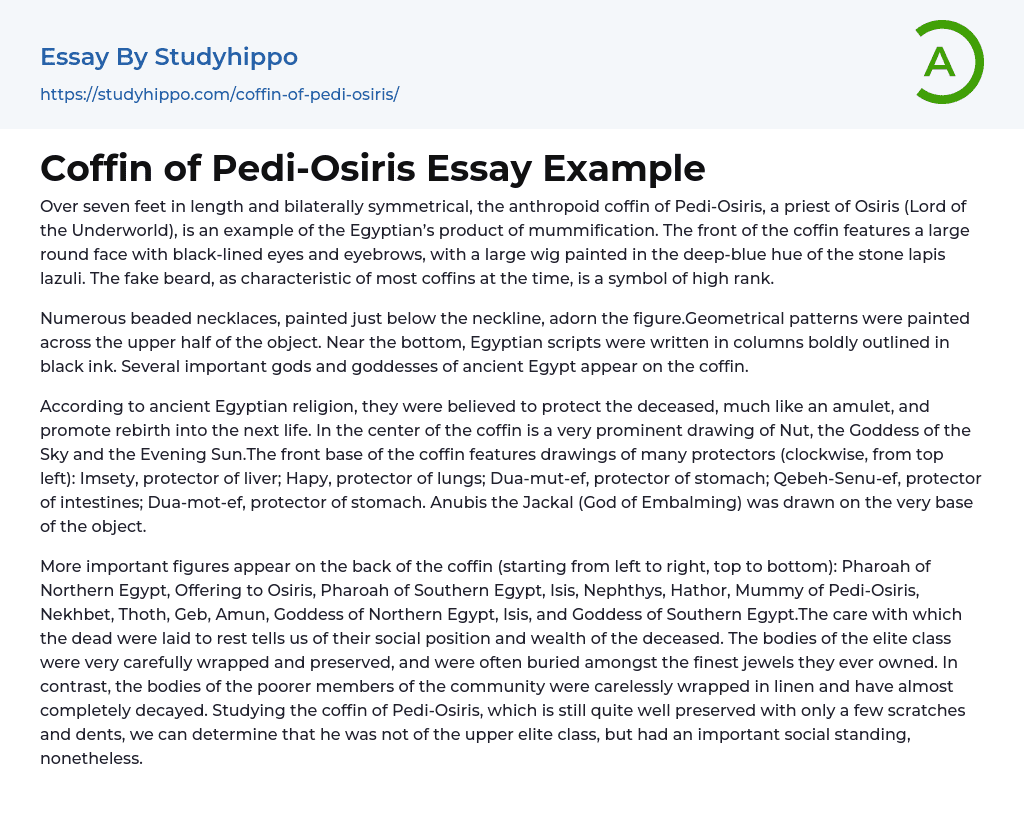Over seven feet in length and bilaterally symmetrical, the anthropoid coffin of Pedi-Osiris, a priest of Osiris (Lord of the Underworld), is an example of the Egyptian’s product of mummification. The front of the coffin features a large round face with black-lined eyes and eyebrows, with a large wig painted in the deep-blue hue of the stone lapis lazuli. The fake beard, as characteristic of most coffins at the time, is a symbol of high rank.
Numerous beaded necklaces, painted just below the neckline, adorn the figure.Geometrical patterns were painted across the upper half of the object. Near the bottom, Egyptian scripts were written in columns boldly outlined in black ink. Several important gods and goddesses of ancient Egypt appear on the coffin.
According to ancient Egyptian religion, they were believed to protect the deceased, muc
...h like an amulet, and promote rebirth into the next life. In the center of the coffin is a very prominent drawing of Nut, the Goddess of the Sky and the Evening Sun.The front base of the coffin features drawings of many protectors (clockwise, from top left): Imsety, protector of liver; Hapy, protector of lungs; Dua-mut-ef, protector of stomach; Qebeh-Senu-ef, protector of intestines; Dua-mot-ef, protector of stomach. Anubis the Jackal (God of Embalming) was drawn on the very base of the object.
More important figures appear on the back of the coffin (starting from left to right, top to bottom): Pharoah of Northern Egypt, Offering to Osiris, Pharoah of Southern Egypt, Isis, Nephthys, Hathor, Mummy of Pedi-Osiris, Nekhbet, Thoth, Geb, Amun, Goddess of Northern Egypt, Isis, and Goddess of Southern Egypt.The care with which the dead were laid to res
tells us of their social position and wealth of the deceased. The bodies of the elite class were very carefully wrapped and preserved, and were often buried amongst the finest jewels they ever owned. In contrast, the bodies of the poorer members of the community were carelessly wrapped in linen and have almost completely decayed. Studying the coffin of Pedi-Osiris, which is still quite well preserved with only a few scratches and dents, we can determine that he was not of the upper elite class, but had an important social standing, nonetheless.
- Tattoo essays
- Baptism essays
- Holy Spirit essays
- Jesus Christ essays
- Adam And Eve essays
- Crucifixion Of Jesus essays
- Crusades essays
- Eucharist essays
- God The Father essays
- Pope essays
- Protestantism essays
- Christian essays
- Church essays
- Elizabeth essays
- Sacrament essays
- Catholic Church essays
- Lord essays
- Priest essays
- Protestant Reformation essays
- Clothing essays
- Footwear essays
- Fashion design essays
- Cosmetic Surgery essays
- Jeans essays
- Russian Empire essays
- Ancient Greece essays
- British Empire essays
- Historical Figures essays
- Nazi Germany essays
- Roman Empire essays
- War essays
- Revolution essays
- 19Th Century essays
- Historiography essays
- History of the United States essays
- 20Th Century essays
- World History essays
- Vikings essays
- Declaration of Independence essays
- Civilization essays
- Evidence essays
- Genocide essays
- Colonialism essays
- Rebellion essays
- 1960S essays
- 1920S essays
- 1950S essays
- Letter from Birmingham Jail essays
- Louisiana Purchase essays
- The Columbian Exchange essays




